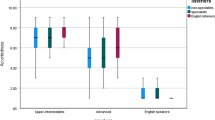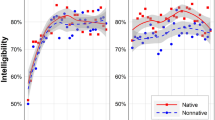Abstract
When adult Canadian French (henceforth CF) learners of English as a second language (L2) speak English, two striking aspects of their French accent are incorrect production of English word stress and incorrect production of vowel reduction (Capliez, 2011; Frost, 2011; Ploquin, 2009; Tremblay and Owens, 2010). Either CF speakers place word stress on the wrong syllable and reduce the vowels of the wrong syllables, or they omit one or both of these pronunciation features altogether.
Access this chapter
Tax calculation will be finalised at checkout
Purchases are for personal use only
Preview
Unable to display preview. Download preview PDF.
Similar content being viewed by others
References
Anderson-Hsieh, J., Johnson, R. and Koehler, K. (1992). The relationship between native speaker judgments of non-native pronunciation and deviance in segmentals, prosody and syllable structure. Language Learning, 42 (4): 529–55.
Beckman, M. E. (1986). Stress and non-stress accent. Dordrecht, the Netherlands: Foris Publications.
Bialystok, E., Craik, F., Green, D. and Gollan, T. (2009). Bilingual minds. Psychological Science in the Public Interest, 10 (3): 89–129.
Boersma, P. and Weenink, D. (2013). Praat: Doing phonetics by computer (Version 5.3.41) [Software]. Available from: http://www.praat.org
Bond, Z. S. (2008). Slips of the ear. In D. B. Pisoni and R. E. Remez (eds), The handbook of speech perception (pp. 290–310). Oxford, UK: Blackwell Publishing.
Bradlow, A. R. and Bent, T. (2008). Perceptual adaptation to non-native speech. Cognition, 106 (2): 707–29.
Braun, B., Lemhöfer, K. and Mani, N. (2011). Perceiving unstressed vowels in foreign-accented English. The Journal of the Acoustical Society of America, 129 (1): 376–87.
Capliez, M. (2011). Typologie des erreurs de production d anglais des francophones: Segments vs. suprasegments. Recherche et Pratiques Pédagogiques en Langues de Spécialité — Cahiers de l’APLIUT, 30 (3): 43–60.
Clarke, C. M. and Garrett, M. R. (2004). Rapid adaptation to foreign-accented English. Journal of the Acoustical Society of America, 116 (6): 3647–58.
Clopper, C. G. (2002). Frequency of stress patterns in English: A computational analysis. Indiana University Linguistics Club (IULC) Working Papers Online, 2 (2): 1–9.
Cooper, N., Cutler, A. and Wales, R. (2002). Constraints of lexical stress on lexical access in English: Evidence from native and non-native listeners. Language and Speech, 45 (3): 207–28.
Cutler, A. (1986). Forbear is a homophone: Lexical prosody does not constrain lexical access. Language and Speech, 29 (3): 201–20.
Cutler, A. (2012). Native listening: Language experience and the recognition of Spoken words. Cambridge, Mass.: MIT Press.
Cutler, A. and Butterfield, S. (1992). Rhythmic cues to speech segmentation: Evidence from juncture misperception. Journal of Memory and Language, 31 (2): 218–36.
Cutler, A. and Clifton, C. (1984). The use of prosodic information in word recognition. In H. Bouma and D. G. Bouwhuis (eds), Attention and performance X: Control of language processes (pp. 183–96). Hillsdale, NJ: Erlbaum.
de Bot, K. (2004). The multilingual lexicon: Modelling selection and control. The International Journal of Multilingualism, 1 (1): 17–32.
Derwing, T. M. and Munro, M. J. (1997). Accent, comprehensibility and intelligibility: Evidence from four L1s. Studies in Second Language Acquisition, 19 (1): 1–16.
Dijkstra, T. (2003). Lexical processing in bilinguals and multilinguals: The word selection problem. In J. Cenoz, B. Hufeisen and U. Jessner (eds), The multilingual lexicon (pp. 11–26). Dordrecht, the Netherlands: Kluwer Academic Publishers.
Field, J. (2005). Intelligibility and the listener: The role of lexical stress. TESOL Quarterly, 39 (3): 399–423.
Francis, W. N. and Kučera, H. (1982). Frequency analysis of English usage: Lexicon and grammar. Boston, Mass.: Houghton Mifflin Company.
Frost, D. (2011). Stress and cues to relative prominence in English and French: A perceptual study. Journal of the International Phonetic Association, 41 (1): 67–84.
Fry, D. B. (1958). Experiments in the perception of stress. Language and Speech, 1, 126–52.
Gass, S. and Varonis, E. M. (1984). The effect of familiarity on the comprehensibility of nonnative speech. Language Learning, 34 (1): 65–89.
Grosjean, F., and Gee, J. (1987). Prosodic structure and spoken word recognition. Cognition, 25: 135–55.
Jiang, N. (2000). Lexical representation and development in a second language. Applied Linguistics, 21 (1): 47–77.
Kennedy, S. and Trofimovich, P. (2008). Intelligibility, comprehensibility, and accentedness of L2 speech: The role of the listener experience and semantic context. The Canadian Modern Language Review/La revue canadienne des languages vivantes, 64 (3): 459–89.
Kuhl, P. and Rivera-Gaxiola, M. (2008). Neural substrates of language acquisition. Annual Review of Neuroscience, 31: 511–24.
LaCharité, D. and Prévost, P. (1999). The role of L1 and of teaching in the acquisition of English sounds by francophones. In A. Greenhill, H. Littlefield and C. Tano (eds), Proceedings of the 23rd Annual Boston University Conference on Language Development (BUCLD) (Vol. 2, pp. 373–85). Somermille, Mass.: Cascadilla Press.
Ladefoged, P. and Johnson, K. (2015). A course in phonetics. Boston, Mass.: Wadsworth/Cengage Learning.
Lehiste, I. (1970). Suprasegmentals. Cambridge, Mass.: MIT Press.
Levelt, W. J. (1989). Speaking: From intention to articulation (Vol. 1). Cambridge, Mass.: MIT Press.
Levis, J. (2011). Assessing speech intelligibility: Experts listen to two students. In J. Levis and K. LeVelle (eds), Proceedings of the 2nd Pronunciation in Second Language Learning and Teaching Conference (pp. 56–69). Ames, Iowa: Iowa State University.
MacKay, I. R. A. (1987). Phonetics: The science of Speech production. Boston, Mass.: Allyn and Bacon.
Major, R. C. (2007). Identifying a foreign accent in an unfamiliar language. Studies in Second Language Acquisition, 29 (04): 539–56.
Major, R. C., Fitzmaurice, S. M., Bunta, F. and Balasubramanian, C. (2002). The effects of nonnative accents on listening comprehension: Implications for ESL assessment. TESOL Quarterly, 36 (2): 173–90.
Marslen-Wilson, W. D. (1985). Speech shadowing and speech comprehension. Speech Communication, 4 (1–3): 55–73.
Marslen-Wilson, W. D. (1987). Functional parallelism in spoken word-recognition. Cognition, 25 (1): 71–102.
Marslen-Wilson, W. D. and Tyler, L. K. (1980). The temporal structure of spoken language understanding. Cognition, 8 (1): 1–71.
Marslen-Wilson, W. D. and Welsh, A. (1978). Processing interactions and lexical access during word recognition in continuous speech. Cognitive Psychology, 10 (1): 29–63.
Mattys, S. L., Jusczyk, P. W., Luce, P. A. and Morgan, J. L. (1999). Word segmentation in infants: How phonotactics and prosody combine. Cognitive Psychology, 39 (3): 465–94.
Mattys, S. L. and Samuel, A. G. (1997). How lexical stress affects speech segmentation and interactivity: Evidence from the migration paradigm. Journal of Memory and Language, 36 (1): 87–116.
Munro, M. J., Derwing, T. M. and Morton, S. L. (2006). The mutual intelligibility of L2 speech. Studies in Second Language Acquisition, 28 (1): 111–31.
Paradis, C. and LaCharité, D. (2001). Guttural deletion in loanwords. Phonology, 18 (2): 255–300.
Ploquin, M. (2009). Phonological issues in the production of prosody by francophone and sinophone learners of English as a second language. Doctoral dissertation. Université du Québec à Montréal, Quebec. Available from: http://www.archipel.uqam.ca/2070/1/D1777.pdf
Samuel, A. G. (1996). Does lexical information influence the perceptual restoration of phonemes? Journal of Experimental Psychology, General, 125 (1): 28–51.
Shipman, D. and Zue, V. (1982, May). Properties of large lexicons: Implications for advanced isolated word recognition systems. International Conference on Acoustics, Speech, and Signal Processing (ICASSP’82), IEEE, (Vol. 7, pp. 546–9). doi: 10.1109/ICASSP.1982.1171902
Slowiaczek, L. M. (1990). Effects of lexical stress in auditory word recognition. Language and Speech, 33 (1): 47–68.
Small, L. H., Simon, S. D. and Goldberg, J. S. (1988). Lexical stress and lexical access: Homographs versus nonhomographs. Perception and Psychophysics, 44 (3): 272–80.
Tremblay, A. and Owens, N. (2010). The role of acoustic cues in the development of (non-)target-like second-language prosodic representations. The Canadian Journal of Linguistics/La revue canadienne de Linguistique, 55 (1): 85–114.
Trude, A. M., Tremblay, A. and Brown-Schmidt, S. (2013). Limitations on adaptation to foreign accents. Journal of Memory and Language, 69 (3): 349–67.
Zielinski, B. W. (2008). The listener: No longer the silent partner in reduced intelligibility. System, 36 (1): 69–84.
Author information
Authors and Affiliations
Editor information
Editors and Affiliations
Copyright information
© 2015 Andrée Lepage and Darlene LaCharité
About this chapter
Cite this chapter
Lepage, A., LaCharité, D. (2015). Perceptions of Intelligibility and RTs: Accent-Tolerant vs Non-Accent-Tolerant Listeners. In: Mompean, J.A., Fouz-González, J. (eds) Investigating English Pronunciation. Palgrave Macmillan, London. https://doi.org/10.1057/9781137509437_5
Download citation
DOI: https://doi.org/10.1057/9781137509437_5
Publisher Name: Palgrave Macmillan, London
Print ISBN: 978-1-137-50942-0
Online ISBN: 978-1-137-50943-7
eBook Packages: Palgrave Education CollectionEducation (R0)




